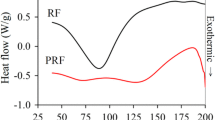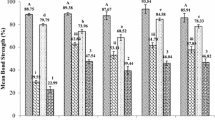Abstract
Blends of phenol resorcinol formaldehyde (PRF) resin with tannin obtained from bark offers the potential to minimise the quantity of resorcinol required in conventional two pot, cold set PRF wood adhesives. In the presence of ammonia, both quebracho and radiata pine bark extracts, resorcinolic and phloroglucinolic type tannins respectively, showed accelerated adhesive cure behaviour with formaldehyde, in a similar manner to PRF adhesive Greenweld technology for modifying glued timber processing rates. Segregation of pine bark components established that only tannin-containing fractions exhibited accelerated adhesive cure behaviour. Results from adhesive testing indicated adhesive blends of quebracho extract and PRF resin failed to attain satisfactory bond strength at full cure. Of the pine bark components, only a pure tannin fraction produced acceptable bond strength when blended with PRF (3:1). The study indicated pine bark extract can be substituted into PRF adhesives and adhesive cure rate accelerated using ammonia. However, extracts containing crude tannin or carbohydrate materials in adhesive blends led to inferior adhesives.
Zusammenfassung
Aus Rinde gewonnene Mischungen aus Phenol-Resorcin-Formaldehyd (PRF)-Harzen mit Tannin bieten die Möglichkeit die Menge an Resorcin bei üblichen zweistufigen PRF-Klebern zu verringern. In Gegenwart von Ammoniak zeigten Quebracho- und Kiefernrinden-Extrakte sowohl vom Resorcin- als auch vom Phoroglucin-Typ eine beschleunigtes Aushärten mit Formaldehyd wie z. B. auch PRF-Harze bei der Greenweld technology zum Modifizieren der Bearbeitungszeiten bei verleimtem Schnittholz. Fraktionieren der Rindenextrakte bestätigte, dass nur Tanninanteile das Aushärten beschleunigen. Die Ergebnisse zeigten, dass Mischungen aus Quebracho-Tannin mit PRF-Harzen nach dem Aushärten nur unbefriedigende Festigkeiten aufwiesen. Von den Kiefernrinden-Extrakten führte nur eine gereinigte Tanninfraktion mit PRF im Verhältnis 3:1 zu annehmbaren Festigkeiten. Die Untersuchung zeigt, dass Kiefernrinden-Extrakte einen Teil der PRF-Harze substituieren und in Gegenwart von Ammoniak das Aushärten beschleunigen kann. Allerdings führen ungereinigte Tannine oder Kohlenhydratanteile in der Harzmischung zu minderwertigen Klebern.






Similar content being viewed by others
References
Conner AH, Lorenz LF, River BH, Hemingway RW (1989) Carbohydrate-modified phenol-formaldehyde resins formulated at neutral conditions. In: Hemingway RW, Conner AH (eds) Adhesives from renewable resources. American Chemical Society, Washington
Dix B, Marutzky R (1988) Tannin formaldehyde resin from barks of spruce and pine. Holz Roh- Werkstoff 46:19–25
Gonzalez J, Pizzi A (1996) Influence of preparation on pine tannin-based cold-set glulam adhesives. Holz Roh- Werkstoff 54:389–392
Hergert HL (1989) In: Hemingway RW, Conner AH (eds) Adhesives from renewable resources, Chapter 12. American Chemical Society, Washington
Kreibich RE, Hemingway RW, Nearn WT (1993) Application of honeymoon cold-set adhesive systems for structural end joints in North America. Forest Prod J 43(7/8):45–48
Kreibich RE, Hemingway RW (1985) Condensed tannin-resorcinol adducts in laminating adhesives. Forest Prod J 35(3):23–25
Kreibich RE, Hemingway RW (1987) Condensed tannin-sulfonate derivatives in cold-setting wood-laminating adhesives. Forest Prod J 37(2):43–46
Kreibich RE (1988) Tannin-based wood adhesives. In: Hemmingway RW, Karchesy JJ (eds) Proceedings of the First North American Tannin Conference. Plenum Press, New York, p 457
Kreibich RE, Hemingway RW (1989) In: Hemingway RW, Conner AH (eds) Adhesives from renewable resources, Chapter 15. American Chemical Society, Washington
Long R (1991) Quebracho based polyphenols for use in wood panel adhesive system, Holz Roh- Werkstoff 49(12):485–487
Parker JR, Taylor JBM, Plackett DV and Lomax TD (1997) Method of joining wood. U.S. Patent 5,674,338
Pizzi A, du T Rossouw D, Knuffel WE, Singmin M (1980) Honeymoon phenolic and tannin-based fast-setting adhesive systems for exterior grade finger-joints. Holzforsch Holzverwert 32:140–150
Pizzi A (1983) Wood adhesives, chemistry and technology, vol 1. Marcel Dekker, New York
Saayman HM, Oatley JA (1976) Wood adhesives from Wattle bark extract. Forest Prod J 26(12):27
Von Leyser E, Pizzi A (1990) The formulation and commercialisation of pine tannin adhesives in Chile. Holz Roh- Werkstoff 48:25–29
Weston RJ, Foo LY (1997) Extraction and characterisation of tannins from Pinus radiata bark. Industrial Research Confidential Report No. 707, IRL New Zealand
BS1204 (1993) Type MR phenolic and aminoplastic synthetic resin adhesives for wood
Acknowledgements
The authors wish to thank the technical assistance of B. Coombridge and C. McIntosh in the development of this work.
Author information
Authors and Affiliations
Corresponding author
Rights and permissions
About this article
Cite this article
Grigsby, W., Warnes, J. Potential of tannin extracts as resorcinol replacements in cold cure thermoset adhesives. Holz Roh Werkst 62, 433–438 (2004). https://doi.org/10.1007/s00107-004-0504-z
Published:
Issue Date:
DOI: https://doi.org/10.1007/s00107-004-0504-z




